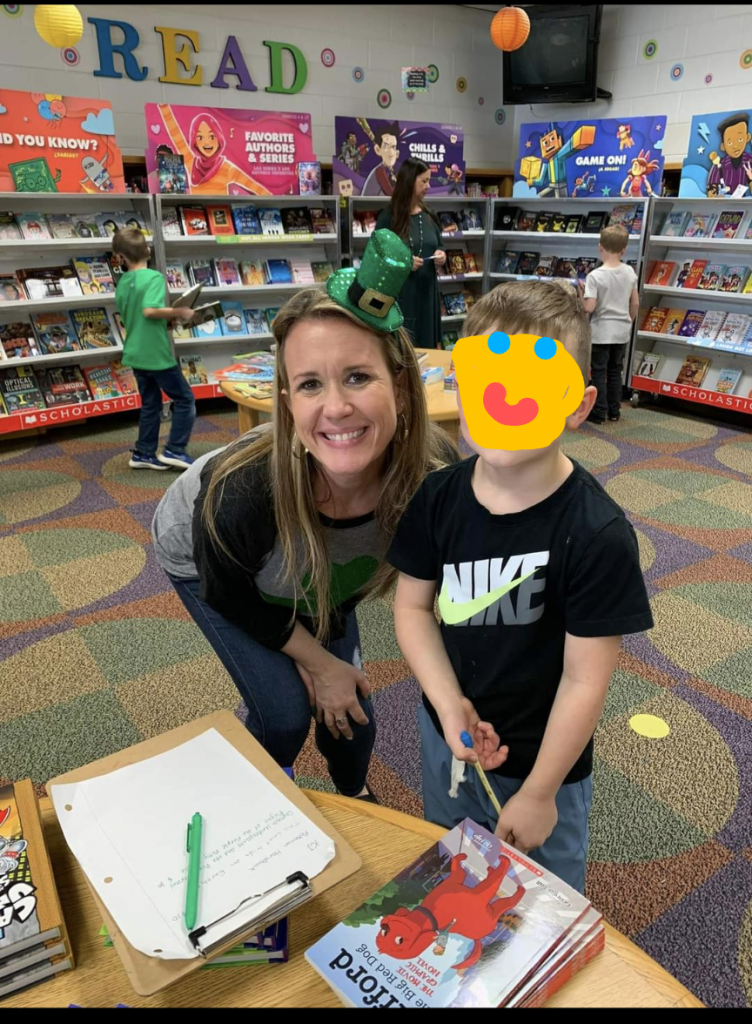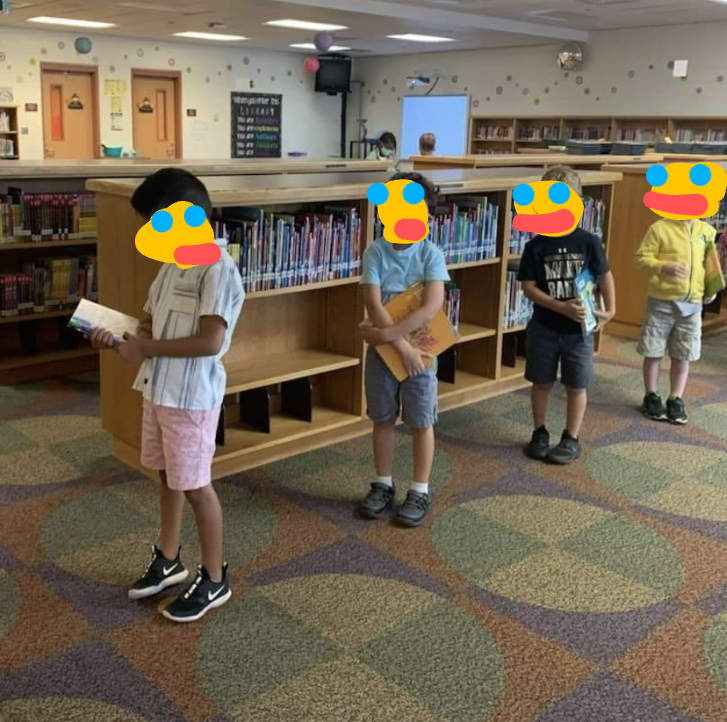
I visited the media center of the elementary school my children both attended, and spoke with librarian Cherie Duda about her job there. Although there were some areas of overlap between this school library and the public library where I work in the Youth and Family Services department, there were also noticeable differences. I enjoyed learning about their daily schedule and the job duties of the librarian and two library assistants during my visit.
The media center at Grassfield Elementary is a bright and welcoming environment, located right across from the main entrance to the school. The room’s glass doors lead straight to shelves of popular series, which I imagine the students immediately rush to when their class arrives to check out books. There are tables with chairs scattered around the space, all child-sized. The biographies are located behind the popular series, and additional bookshelves wrap around the room. Nonfiction, which is arranged by the Dewey decimal system, is in the middle, fiction is arranged alphabetically on the back wall, and picture books are on a side wall. Every single book has a large color coded circle sticker on the spine, which corresponds with reading levels and helps children determine what they should be able to read. Mrs. Duda and I spoke about the choice to use assigned reading levels, since there has been discussion about the negatives of pushing reading levels on emerging readers in our coursework. According to an interview with Fountas and Pinnell, the creators of the widely popular A to Z gradient scale (which is used in the GFE media center), the alphabetic reading level labels were never meant to be used to select books, but rather to help provide a “map of reading progress…a systematic, standardized way to determine where children are along that progression of competencies…It is our belief that levels have no place in classroom libraries, in school libraries, in public libraries, or on report cards.” (Parrott, 2017). However, both GFE students and parents are informed of where they sit on the F&P Text Level Gradient, and they know how they are expected to progress through the levels. In defending the media center’s use of this system, Mrs. Duda explained that it helps guide the children to their best options, and they can then decide whether or not a specific book appeals to them. There are usually two classes in the library at a time, with up to sixty students browsing, so getting individualized reader’s advisory from the librarian or either library assistant is not always possible. I can see the merits of this argument for using reading levels, especially since children tend to advance rapidly throughout the school year, and may need help identifying new options as their level changes.
GFE has a school website which lists general information, but there is no specific page for the library. I did find the email for Mrs. Duda on the main school site, as well as details for an upcoming book fair being held to raise money for purchasing new books. Students can login to a portal which gives them access to Destiny and Epic, two e-resource platforms, as well as LightBox which provides interactive e-books to help engage children in nonfiction subjects. The media center does not have much in the way of technology, since students go to a separate computer lab as a weekly resource class. Mrs. Duda uses a Smartboard in her lessons and the students have individual Chromebooks. Mrs. Duda keeps track of item circulation and e-resource use with a professional statistics program, which she explained to me in detail. I think it would be very helpful to have that extensive information on hand, and I wish my public library system had something similar to assist with book ordering.
Mrs. Duda and I discussed serving a diverse student population, and making sure the collection reflects their individual needs. She described the special items she keeps on hand for students with different abilities and needs. There is a selection of books in Braille for a student who is visually impaired, and board books for those who are developmentally delayed. GFE does not have many bilingual books, but there are some in Spanish in the collection. Mrs. Duda began her career in education as a fifth grade teacher, and she uses this classroom background to plan lessons. Each class visits the media center weekly, on a two week schedule rotation: the first week they check out items (resulting in hundreds of items being processed daily), and the second week Mrs. Duda teaches a lesson according to whatever topic is currently being covered by teachers for the Standard of Learning test in their grade level.
During the COVID-19 pandemic, GFE conducted classes virtually for the last three months of the school year, and the first few months of the beginning of the next. Mrs. Duda continued teaching according to her lesson plans over Zoom meets, and classes saw her once a week. After in-person learning resumed, a library cart was brought to each classroom with books for checkout, and Mrs. Duda would teach each class for thirty minutes weekly. She and her assistants, as well as the students, were very happy with the return to regular library access and sessions.
One of the main things that struck me about Mrs. Duda was her passion for her job and the students she serves. I asked about job creep and burnout, especially during the pandemic, and she admitted there was a learning curve to going virtual. However, when I asked if it was overwhelming, or if she feels that she takes on too much, her reply was negative. She emphatically informed me that she does everything for the kids, that she loves her students dearly, and that her favorite part of the job is helping them become better readers. In our course textbook, Rubin and Rubin stress that “education in the twenty-first century will be learner-centered, with personalized learning tailored to the needs of each student, and responsive to cultural differences in a real-world context (2017, p. 152). Cherie Duda is an excellent example of a librarian who meets these ideals with enthusiasm and energy.
Resources
Parrott, K. (2017). Fountas and Pinnell say librarians should guide readers by interest, not level. School Library Journal. https://www.slj.com//story/fountas-pinnell-say-librarians-guide-readers-interest-not-level
Rubin, R. E. & Rubin, R. G. (2020). Foundations of library and information science (5th ed.). ALA Neal-Schuman.

Hi Hannah,
Thank you so much for sharing about your kids’ school library and their passionate librarian! I especially liked hearing her opinion on leveling the books. That was actually the topic of my Speaking Notes assignment – whether or not the juvenile books in libraries should be labeled by reading level. I definitely see the pros and cons to both sides, especially since I have been working as a reading specialist at an elementary school for the past 9 years. My speaking notes were more geared toward the public library setting, and if the books should be labeled to help parents choose books for their children. However, it’s true that there are not always enough staff and time in school libraries to help students select books, so I do see how the colored dots can help guide them in the right direction. I think it’s important to know that there is a risk of “turning struggling readers into non-readers” (American Library Association, 2019), when assigning reading levels to juvenile books and limiting their reading options. However, I personally feel that it comes down to balance and still making sure to incorporate student choice. It sounds like the librarian you spoke to has found a nice balance with allowing the colors to be a guide but still allowing student choice within that. I think it becomes more problematic when students are only allowed to choose books of a certain color – as I have seen in a previous elementary school I worked in.
References
American Library Association (2019, June 24). Labeling and rating systems Q&A. https://www.ala.org/advocacy/intfreedom/labelingratingqa
Katie,
I went back and re-read both your Speaking Notes presentation and your source material, because I found it so enlightening! I have been discussing our choice of leveling books at my public library branch with my co-workers, and we are still arguing both sides of the topic. It really can present a challenge for librarians! I greatly appreciate the work you did on the subject, and the fact that it opened my eyes to both sides of the discussion.
Hey Hannah,
Love the faces on the pictures – makes them too cute. First and foremost, I adore that Ms. Duda replied that she does everything for her students and doesn’t feel job creep or added stress in the amount of work that needs to be done! You know what they say about never working a day in your life if you love what you do. I certainly feel this way. I was definitely interested in the color coded reading levels based on Fountas Pinnell and the statement by them regarding the system not being used in libraries and Mrs. Duda’s defense of the labels being a guide to help them decide appeal. This is one I have struggled with as a classroom teacher using computer programs for grammar such as IXL that state the grade level of practice by number, or if you choose by letter which the children are completely able to figure out, and how that affects those who are lower or slower in their progression. As I work as a classroom teacher and assistant librarian I always want to push my students to read and to find materials that suit their level and interest without them feeling demoralized if they are lower. I wonder if putting the labels inside the cover as a guide to appropriate levels would help them choose interest first and level second then possibly pushing themselves a bit if they are truly interested in a topic or title. Just thinking out loud here! So, Lightbox is interesting – I keep squirreling off to visit websites and don’t seem to be making any progress on my posts here, so sorry. It seems like a great program. I wonder if kids enjoy it or if it is viewed like Newsela, teachers love it, kids give it a big yawn 🙂